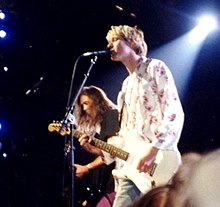| Grunge | |
|---|---|
 American rock band Nirvana (pictured in 1992) is the most commercially successful band of the genre, having sold over 27 million albums in the United States alone. | |
| Stylistic origins | |
| Cultural origins | Mid-1980s, Seattle, Washington |
| Derivative forms | Post-grunge |
| Regional scenes | |
| Washington | |
| Other topics | |
Grunge (sometimes referred to as the Seattle sound) is an alternative rock genre and subculture which emerged during the mid-1980s in the U.S. state of Washington, particularly in Seattle and nearby towns. Grunge fuses elements of punk rock and heavy metal.[3] The genre featured the distorted electric guitar sound used in both genres, although some bands performed with more emphasis on one or the other. Like these genres, grunge typically uses electric guitar, bass guitar, drums and vocals. Grunge also incorporates influences from indie rock bands such as Sonic Youth. Lyrics are typically angst-filled and introspective, often addressing themes such as social alienation, self-doubt, abuse, neglect, betrayal, social and emotional isolation, addiction, psychological trauma and a desire for freedom.[5][6]
The early grunge movement revolved around Seattle's independent record label Sub Pop and the region's underground music scene. The owners of Sub Pop marketed the style shrewdly, encouraging the media to describe it as "grunge"; the style became known as a hybrid of punk and metal.[7] By the early 1990s, its popularity had spread, with grunge bands appearing in California, then emerging in other parts of the United States and in Australia, building strong followings and signing major record deals. Grunge was commercially successful in the early-to-mid-1990s due to releases such as Nirvana's Nevermind, Pearl Jam's Ten, Soundgarden's Badmotorfinger, Alice in Chains' Dirt, and Stone Temple Pilots' Core. The success of these bands boosted the popularity of alternative rock and made grunge the most popular form of rock music.[8]
Several factors contributed to grunge's decline in prominence. During the mid-to-late 1990s, many grunge bands broke up or became less visible. Nirvana's Kurt Cobain, labeled by Time as "the John Lennon of the swinging Northwest", struggled with an addiction to heroin before his suicide in 1994. Although most grunge bands had disbanded or faded from view by the late 1990s, they influenced modern rock music, as their lyrics brought socially conscious issues into pop culture[9] and added introspection and an exploration of what it means to be true to oneself.[10] Grunge was also an influence on later genres such as post-grunge.
- ^ Nelson, Kim (December 10, 2018). "How St. Paul punk pioneers Hüsker Dü paved the way for grunge music". MinnPost. Retrieved August 19, 2020.
- ^ Azerrad, Michael (2018). Our Band Could Be Your Life. p. 439.
- ^ a b c Cite error: The named reference
anderson2007C1was invoked but never defined (see the help page). - ^ a b DiBlasi, Alex. "Grunge" in Music in American Life: An Encyclopedia of the Songs, Styles, Stars and Stories that Shaped Our Culture, p. 520-524. Edited by Jacqueline Edmondson. ABC-CLIO, 2013. p. e520
- ^ Perone, James E. (October 17, 2012). The Album: A Guide to Pop Music's Most Provocative, Influential, and Important Creations [4 Volumes]: A Guide to Pop Music's Most Provocative, Influential, and Important Creations. ABC-CLIO. ISBN 978-0313379079. Retrieved October 22, 2018.
- ^ Fournier, Karen (January 16, 2016). The Words and Music of Alanis Morissette. ABC-CLIO. ISBN 978-1440830693. Retrieved October 22, 2018.
- ^ Goldberg, Danny (2019). "Ch.4-Nevermind". Serving the Servant: Remembering Kurt Cobain (1 ed.). HarperCollins. p. 76. ISBN 978-0062861504.
- ^ "Grunge". AllMusic. Retrieved August 24, 2012.
- ^ Danaher, Michael (August 4, 2014). "The 50 Best Grunge Songs". Paste. Archived from the original on February 11, 2017. Retrieved February 8, 2017.
- ^ Felix-Jager, Steven. With God on Our Side: Towards a Transformational Theology of Rock and Roll. Wipf and Stock Publishers, 2017. p. 134